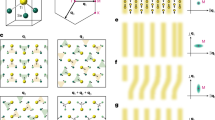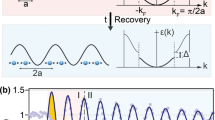Abstract
Ultrafast manipulation of vibrational coherence provides a route to control the structure of solids. However, this strategy can only induce long-range correlations and cannot modify atomic structure locally, which is a requirement for many technological applications such as non-volatile electronics. Here we demonstrate that ultrafast lasers can generate incoherent structural fluctuations that are more efficient for material control than coherent vibrations, extending optical control to a wide range of materials. We observe that local non-equilibrium lattice distortions generated by a weak laser pulse reduce the energy barrier to switch between insulating and metallic states in vanadium dioxide. Seeding inhomogeneous structural fluctuations presents an alternative, more energy-efficient, route for controlling materials that may be applicable to all solids, including those used in data- and energy-storage devices.
This is a preview of subscription content, access via your institution
Access options
Access Nature and 54 other Nature Portfolio journals
Get Nature+, our best-value online-access subscription
$29.99 / 30 days
cancel any time
Subscribe to this journal
Receive 12 print issues and online access
$209.00 per year
only $17.42 per issue
Buy this article
- Purchase on Springer Link
- Instant access to full article PDF
Prices may be subject to local taxes which are calculated during checkout




Similar content being viewed by others
Data availability
Source data are available with this paper. Other data that support the findings of this study are available from the corresponding authors upon reasonable request. The DFT computed structures can be found in the ioChem-BD repository at https://doi.org/10.19061/iochem-bd-1-312 (ref. 40).
References
Simpson, R. E. et al. Interfacial phase-change memory. Nat. Nanotechnol. 6, 501–505 (2011).
Teo, T. Y. et al. Programmable chalcogenide-based all-optical deep neural networks. Nanophotonics 11, 4073–4088 (2022).
Loke, D. et al. Breaking the speed limits of phase-change memory. Science 336, 1566–1569 (2012).
Simpson, R. E. et al. Toward the ultimate limit of phase change in Ge2Sb2Te5. Nano Lett. 10, 414–419 (2010).
Matsunaga, T. et al. From local structure to nanosecond recrystallization dynamics in AgInSbTe phase-change materials. Nat. Mater. 10, 129–134 (2011).
Samizadeh Nikoo, M. et al. Electrical control of glass-like dynamics in vanadium dioxide for data storage and processing. Nat. Electron. 5, 596–603 (2022).
Binder, K. Theory of first-order phase transitions. Rep. Prog. Phys. 50, 783–859 (1987).
de la Torre, A. et al. Colloquium: nonthermal pathways to ultrafast control in quantum materials. Rev. Mod. Phys. 93, 041002 (2021).
Giannetti, C. et al. Ultrafast optical spectroscopy of strongly correlated materials and high-temperature superconductors: a non-equilibrium approach. Adv. Phys. 65, 58–238 (2016).
Sokolowski-Tinten, K. et al. Femtosecond X-ray measurement of coherent lattice vibrations near the Lindemann stability limit. Nature 422, 287–289 (2003).
Beaud, P. et al. A time-dependent order parameter for ultrafast photoinduced phase transitions. Nat. Mater. 13, 923–927 (2014).
Hase, M. et al. Optical control of coherent optical phonons in bismuth films. Appl. Phys. Lett. 69, 2474–2476 (1996).
Wall, S. et al. Ultrafast changes in lattice symmetry probed by coherent phonons. Nat. Commun. 3, 721 (2012).
Horstmann, J. G. et al. Coherent control of a surface structural phase transition. Nature 583, 232–236 (2020).
Maklar, J. et al. Coherent light control of a metastable hidden state. Sci. Adv. 9, eadi4661 (2023).
Hildner, R., Brinks, D. & Van Hulst, N. F. Femtosecond coherence and quantum control of single molecules at room temperature. Nat. Phys. 7, 172–177 (2011).
Dantus, M. Coherent nonlinear spectroscopy: from femtosecond dynamics to control. Annu. Rev. Phys. Chem. 52, 639–679 (2001).
Warren, W. S., Rabitz, H. & Dahleh, M. Coherent control of quantum dynamics: the dream is alive. Science 259, 1581–1589 (1993).
Shao, Z., Cao, X., Luo, H. & Jin, P. Recent progress in the phase-transition mechanism and modulation of vanadium dioxide materials. NPG Asia Mater. 10, 581–605 (2018).
Wall, S. et al. Tracking the evolution of electronic and structural properties of VO2 during the ultrafast photoinduced insulator-metal transition. Phys. Rev. B 87, 115126 (2013).
Baum, P., Yang, D. S. & Zewail, A. H. 4D visualization of transitional structures in phase transformations by electron diffraction. Science 318, 788–792 (2007).
Cavalleri, A., Dekorsy, T., Chong, H. H. W., Kieffer, J. C. & Schoenlein, R. W. Evidence for a structurally-driven insulator-to-metal transition in VO2: a view from the ultrafast timescale. Phys. Rev. B 70, 161102(R) (2004).
Wall, S. et al. Ultrafast disordering of vanadium dimers in photoexcited VO2. Science 362, 572–576 (2018).
De La Peña Muñoz, G. A. et al. Ultrafast lattice disordering can be accelerated by electronic collisional forces. Nat. Phys. https://doi.org/10.1038/s41567-023-02118-z (2023).
Demsar, J., Biljaković, K. & Mihailovic, D. Single particle and collective excitations in the one-dimensional charge density wave solid K0.3MoO3 probed in real time by femtosecond spectroscopy. Phys. Rev. Lett. 83, 800–803 (1999).
Huber, T. et al. Coherent structural dynamics of a prototypical charge-density-wave-to-metal transition. Phys. Rev. Lett. 113, 026401 (2014).
Waldecker, L. et al. Time-domain separation of optical properties from structural transitions in resonantly bonded materials. Nat. Mater. 14, 991–995 (2015).
Wegkamp, D. et al. Instantaneous band gap collapse in photoexcited monoclinic VO2 due to photocarrier doping. Phys. Rev. Lett. 113, 216401 (2014).
Keen, D. A. & Goodwin, A. L. The crystallography of correlated disorder. Nature 521, 303–309 (2015).
Brazovskii, S. Self-localized excitations in the Peierls-Frahlich state. Sov. Phys. JETP 51, 342–353 (1980).
Pastor, E. et al. In situ observation of picosecond polaron self-localisation in α-Fe2O3 photoelectrochemical cells. Nat. Commun. 10, 3962 (2019).
Grandi, F., Amaricci, A. & Fabrizio, M. Unraveling the Mott-Peierls intrigue in vanadium dioxide. Phys. Rev. Res. 2, 013298 (2020).
Budai, J. D. et al. Metallization of vanadium dioxide driven by large phonon entropy. Nature 515, 535–539 (2014).
Henke, B. L., Gullikson, E. M. & Davis, J. C. X-Ray interactions: photoabsorption, scattering, transmission, and reflection at E = 50-30,000 eV, Z = 1-92. At. Data Nucl. Data Tables 54, 181–342 (1993).
Vidas, L. et al. Does VO2 host a transient monoclinic metallic phase? Phys. Rev. X 10, 031047 (2020).
Kresse, G. & Hafner, J. Ab initio molecular dynamics for liquid metals. Phys. Rev. B 47, 558–561 (1993).
Perdew, J. P., Burke, K. & Ernzerhof, M. Generalized gradient approximation made simple. Phys. Rev. Lett. 78, 1396 (1997).
Dudarev, S. L., Botton, G. A., Savrasov, S. Y., Humphreys, C. J. & Sutton, A. P. Electron-energy-loss spectra and the structural stability of nickel oxide: an LSDA+U study. Phys. Rev. B 57, 1505–1509 (1998).
Sun, J., Ruzsinszky, A. & Perdew, J. P. Strongly constrained and appropriately normed semilocal densityfunctional. Phys. Rev. Lett. 115, 036402 (2015).
Benzidi, H. VO2-R collection home page. ioChem-BD https://doi.org/10.19061/iochem-bd-1-312 (2023).
Acknowledgements
X-ray measurements were performed at BL3 of SACLA with the approval of the Japan Synchrotron Radiation Research Institute (JASRI) (proposal nos. 2018A8007, 2019A8038 and 2019B8075). A.S.J. acknowledges support from ERC AdG NOQIA; MICIN/AEI (PGC2018-0910.13039/501100011033, CEX2019-000910-S/10.13039/501100011033, PID2022-137817NA-I00, Plan National FIDEUA PID2019-106901GB-I00, FPI; MICIIN with funding from European Union NextGenerationEU (PRTR-C17.I1): QUANTERA MAQS PCI2019-111828-2); MCIN/AEI/ 10.13039/501100011033 and by the ‘European Union NextGeneration EU/PRTR’ QUANTERA DYNAMITE PCI2022-132919 within the QuantERA II Programme that has received funding from the European Union’s Horizon 2020 research and innovation programme under Grant Agreement No. 101017733Proyectos de I + D + I ‘Retos Colaboración’ QUSPIN (RTC2019-007196-7); Fundació Cellex; Fundació Mir-Puig; Generalitat de Catalunya (European Social Fund FEDER and CERCA programme, AGAUR Grant No. 2021 SGR 01452, QuantumCAT\U16-011424, co-funded by ERDF Operational Program of Catalonia 2014-2020); Barcelona Supercomputing Center MareNostrum (FI-2023-1-0013); EU (PASQuanS2.1, 101113690); EU Horizon 2020 FET-OPEN OPTOlogic (Grant No. 899794); EU Horizon Europe Programme (Grant Agreement 101080086—NeQST), National Science Centre, Poland (Symfonia Grant No. 2016/20/W/ST4/00314); ICFO Internal ‘QuantumGaudi’ project; and European Union’s Horizon 2020 research and innovation programme under the Marie Skłodowska-Curie Grant Agreement No. 101029393 (STREDCH) and No. 847648 (‘La Caixa’ Junior Leader fellowships ID100010434: LCF/BQ/PI19/11690013, LCF/BQ/PI20/11760031, LCF/BQ/PR20/11770012, LCF/BQ/PR21/11840013). This project has received funding from the ‘Presidencia de la Agencia Estatal de Investigación’ within the PRE2020-094404 predoctoral fellowship, the Spanish Ministry of Science and Innovation (Ref. No. PID2021-122516OB-I00, Severo Ochoa Center of Excellence CEX2019-000925-S 10.13039/501100011033). T.K. acknowledges support from JSPS KAKENHI (Grant Nos. JP19H05782, JP21H04974 and JP21K18944). E.P. acknowledges the support from IJC2018-037384-I funded by MCIN/AEI /10.13039/501100011033 as well as the support from the CNRS and the French Agence Nationale de la Recherche (ANR), under grant ANR-22-CPJ2-0053-01, funded/co-funded by the European Union (ERC, PhotoDefect, 101076203). Views and opinions expressed are however those of the authors only and do not necessarily reflect those of the European Union or the European Research Council. Neither the European Union nor the granting authority can be held responsible for them. S.K. acknowledges support from National Research Foundation of Korea grant NRF- 2019R1A6B2A02100883. G.A.d.l.P.M., V.K. and M.T. were supported by the US Department of Energy, Office of Science, Office of Basic Energy Sciences through the Division of Materials Sciences and Engineering, under Contract No. DE-AC02-76SF00515. S.E.W. was supported by Carlsbergfondet (CF20-0169).
Author information
Authors and Affiliations
Contributions
S.E.W. and M.T. conceived of the project. S.B.P. and E.P. performed the optical measurements and analysed the data together with A.S.J. and S.E.W. A.S.J., E.P., T.K., G.A.d.l.P.M., V.K., S.K., M.T. and S.E.W. performed diffuse scattering measurements. A.S.J. and G.A.d.l.P.M. analysed the X-ray data. H.B. and N.L. performed the DFT simulations. A.S.J., E.P., N.L. and S.E.W. wrote the paper with input from all authors.
Corresponding authors
Ethics declarations
Competing interests
The authors declare no competing interests.
Peer review
Peer review information
Nature Physics thanks the anonymous reviewers for their contribution to the peer review of this work.
Additional information
Publisher’s note Springer Nature remains neutral with regard to jurisdictional claims in published maps and institutional affiliations.
Supplementary information
Supplementary Information
Supplementary Figs. 1–4 and discussion.
Source data
Source Data Fig. 1
Tabulated data files for all data panels in Fig. 1.
Source Data Fig. 2
Tabulated data files for all data panels in Fig. 2.
Rights and permissions
Springer Nature or its licensor (e.g. a society or other partner) holds exclusive rights to this article under a publishing agreement with the author(s) or other rightsholder(s); author self-archiving of the accepted manuscript version of this article is solely governed by the terms of such publishing agreement and applicable law.
About this article
Cite this article
Johnson, A.S., Pastor, E., Batlle-Porro, S. et al. All-optical seeding of a light-induced phase transition with correlated disorder. Nat. Phys. (2024). https://doi.org/10.1038/s41567-024-02474-4
Received:
Accepted:
Published:
DOI: https://doi.org/10.1038/s41567-024-02474-4



